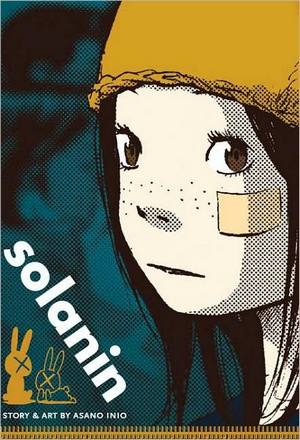- Comics
- Comics Reviews
- Manga
- Comics Reviews
- European Comics
- News
- Comics News
- Press Releases
- Columns
- Spotlight
- Digital Comics
- Webcomics
- Cult Favorite
- Back Issues
- Webcomics
- Movies
- Toys
- Store
- More
- About
By Leroy Douresseaux
October 24, 2008 - 10:02
 |
| Thanks to barnesandnoble.com for the above cover image. |
Rated “T+” for “Older Teen”
In the manga/graphic novel, Solanin, written and drawn by Inio Asano, a recent college graduate and her small circle of friends straddle that borderline between life as a college student and life as a working adult.
Meiko Inoue has been working in an office job that she hates since she graduated. She has smartly saved enough money to support herself for several months if she were out of work, so she takes advantage of that nest egg of cash and quits her job. However, quitting her job wasn’t all about hating it. Meiko’s boyfriend, Naruo Taneda has been crashing at her apartment for what’s starting to seem like a permanent basis because his part time graphic designer job doesn’t pay him enough to rent his own place.
By quitting her job, Meiko hopes to put the pressure on Taneda to make him seek more stable employment with better pay. She’d like Taneda to take his band, Rotti, for which he is lead singer and bassist, and a career in music more seriously. On the other hand, maybe he’s not the only one feeling that he’s not cut out to be part of the real world.
THE LOWDOWN: Although Solanin is a comic book from Japan, and therefore called manga, its story and characters are universal. Even the setting, Tokyo, Japan, looks and feels like any other large city in the world where young people work and struggle with independence, adult issues, and what to do with the rest of their lives. Inio Asano’s lovely art and all the visual elements – composition, page design, lettering, toning, toning effects – are examples of how much the overall visual presentation, beyond basic plot or story, can sell the mood and philosophical underpinnings of a graphic narrative or comic book. Honestly, I’m in love with these superb renderings of the human figure and the urban backdrop.
Considering that her characters seem so stuck in a holding pattern and frozen in fear of moving on with their lives, Inio Asano’s compositions and panel designs are fluid and lively. Her art presents the world of Solanin (the title of a song written by Taneda) that allows readers to view Meiko and company from a seemingly infinite number of angles and close-ups. This certainly connects the reader with the characters, particularly lead character Meiko. Her confusion, stubbornness, determination, frustration, and desperation, as well as her need to cling to a few things that seem permanent, especially Taneda, simply resonate.
POSSIBLE AUDIENCE: While Solanin isn’t strictly josei (comics for adult women), neither is it a teen graphic novel. Call it a Japanese graphic novel and a drama that speaks to any readers who have experienced or are experiencing post-college blues.
A-